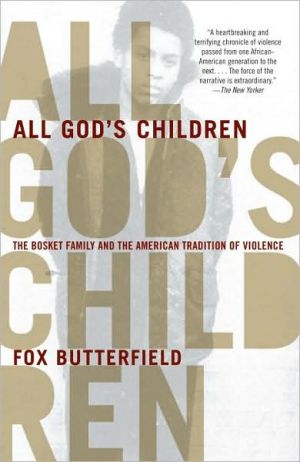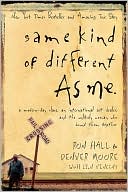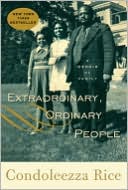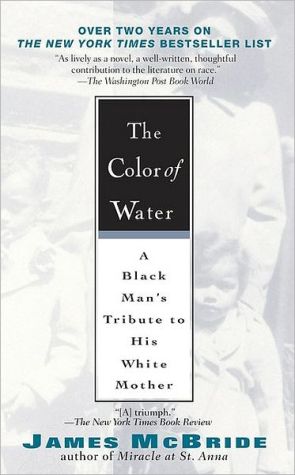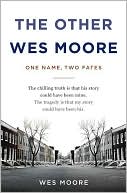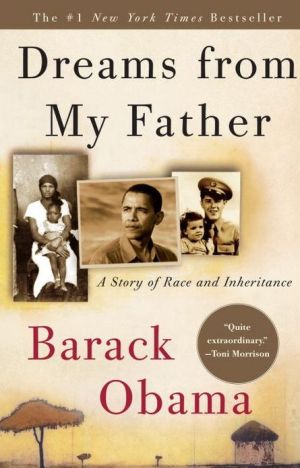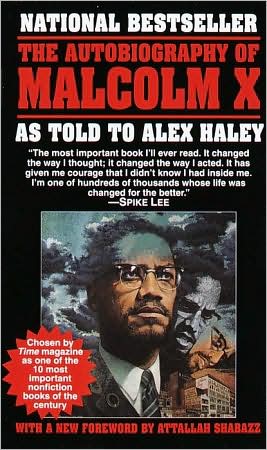All God's Children: The Bosket Family and the American Tradition of Violence
A timely reissue of Fox Butterfield’s masterpiece, All God’s Children, a searing examination of the caustic cumulative effect of racism and violence over 5 generations of black Americans.\ Willie Bosket is a brilliant, violent man who began his criminal career at age five; his slaying of two subway riders at fifteen led to the passage of the first law in the nation allowing teenagers to be tried as adults. Butterfield traces the Bosket family back to their days as South Carolina slaves and...
Search in google:
A timely reissue of Fox Butterfield’s masterpiece, All God’s Children, a searing examination of the caustic cumulative effect of racism and violence over 5 generations of black Americans. Willie Bosket is a brilliant, violent man who began his criminal career at age five; his slaying of two subway riders at fifteen led to the passage of the first law in the nation allowing teenagers to be tried as adults. Butterfield traces the Bosket family back to their days as South Carolina slaves and documents how Willie is the culmination of generations of neglect, cruelty, discrimination and brutality directed at black Americans. From the terrifying scourge of the Ku Klux Klan during Reconstruction to the brutal streets of 1970s New York, this is an unforgettable examination of the painful roots of violence and racism in America.Publishers WeeklyWide-ranging and somewhat unwieldy, this ambitious book tells a challenging, memorable story about race, violence and our American future. Investigating the case of Willie Bosket, whose crimes as a New York juvenile presaged a surge of youth violence and spurred much tougher prosecution of juveniles, New York Times correspondent Butterfield (China: Alive in the Bitter Sea) delved into the Bosket family background. He argues that the white Southern mentality of easily aggrieved honor has made its way through time and the descendants of slaves, transmuted into the similar hair-trigger ethos of inner-city streets. While Butterfield's thesis doesn't completely convince (what about the barrios or the wild west?), his reporting on the lives, crimes and prison experiences of Willie and his father, Butch, is painfully gripping. Finally released after reforming himself in prison, Butch couldn't handle freedom and killed himself as police pursued him. Willie, in prison for life, considers himself ``a monster created by the system.'' In an epilogue, the author warns that building prisons won't solve our crime problem, and he proposes several policies-including intervention programs to help adolescent delinquents-to prevent future carnage. Photos not seen by PW. (Oct.)
CHAPTER I\ "BLOODY EDGEFIELD"\ Edgefield . . . has had more dashing, brilliant, Romantic figures, statesmen, orators, soldiers, adventurers, daredevils, than any county of South Carolina, if not any rural county in America . . . They gave to their village and county a character that was South Carolinian, more intense, more fiery, than was found elsewhere.\ William Watts Bell, The State That Forgot\ IN EARLY NOVEMBER 1781, with the outcome of the American Revolution much in doubt, Captain James Butler of the South Carolina militia got word that a raiding party of Tory loyalists had seized a herd of cattle and a bevy of horses from his neighbors. His fellow settlers at Mount Willing, little more than a forest clearing in the backcountry wilderness, urged him to lead a force to pursue the marauders. Butler demurred. He had been released from eighteen months in a British jail in Charleston only weeks before. He had suffered enough, he said, and his farm needed tending.\ Butler had immigrated to the South Carolina backcountry in the early 1760s over the great wagon trail that led from Pennsylvania through the Shenandoah Valley of Virginia, then the most heavily traveled road in America. With him came his wife, two sisters, and a growing family, which now numbered eight children in all. The Butlers were of Scotch-Irish descent, part of a huge wave of 250,000 immigrants who arrived in Pennsylvania between 1715 and 1775 from the north of England, Scotland, and northern Ireland. They spoke English, not Gaelic, but had a lilting cadence in their voices, an accent preserved in the speech of the South today. These Scotch-Irish were a poor but proud people who had left their homelands after centuries of incessant warfare. In temperament, they were tough, blunt, touchy, hard-drinking, and pugnacious.\ The Butlers' new land in South Carolina was promising. It lay halfway between the Blue Ridge Mountains and the Atlantic Ocean in what would become Edgefield County. There were great primeval forests of oak and hickory and endless stretches of longleaf pine. In the spring, the undergrowth was clothed in splashes of pink, white, and magenta by dogwood and azaleas. Swarms of wild turkeys, geese, ducks, and pigeons darkened the sky. Everywhere there was an abundance of small streams and rivers for water. Along their banks, stands of sugarcane grew in profusion, often reaching higher than a man's head. The red clay soil was rich, good for growing corn and grazing cattle and horses. Some of the settlers experimented with cotton, but until Eli Whitney invented the cotton gin across the nearby Savannah River in Georgia in 1793, separating the seeds from the fiber was too difficult to make it a profitable crop. Still, a few of this first generation in the backcountry, including the Butlers, had already acquired enough wealth to buy black slaves.\ But if the land was rich, life had proven vicious. Since 1760, spanning the whole time the Butlers had been in South Carolina, the area around them had been engaged in some of the cruelest fighting in American history. The conflict had started with a massacre in 1760 by Cherokee Indians that killed scores of settlers. In one attack, the seventy-six-year-old grandmother of John C. Calhoun, a future vice president of the United States and the greatest of all the Carolinians, was murdered in an ambush with twenty-two other people.\ By 1761, when the Cherokee were defeated, much of the backcountry was devastated. Homeless veterans formed outlaw gangs that abducted young women from their villages and tortured wealthy planters and merchants to make them reveal where they had hidden their valuables. Infuriated by this lawlessness, the more respectable settlers formed themselves into "Regulators" to break up the gangs. It was the first organized vigilante justice in America.\ The Regulators succeeded. But they were so brutal that the leading historian of the movement, Richard Maxwell Brown, has argued that "they introduced the strain of violence and extremism that was to be the curse of the upcountry and the nemesis of South Carolina" for more than a century. Often they were sadistic. One group of fifty Regulators who captured a "roguish and troublesome" fellow, said to be a horse thief, stripped him and tied him to a tree with a wagon chain. Then they each took turns giving him ten lashes, for a bloody total of five hundred stripes, to the accompaniment of a drum and fiddle.\ An uneasy calm ensued in the early 1770s, but the fighting erupted even more violently with the advent of the American Revolution in 1775. Along with the battles between the Continental and British armies, there was a guerrilla war of family against family and neighbor against neighbor; it was carried on by ambush, atrocity, and plunder. "No conflict within the borders of the United States has surpassed the South Carolina Back Country civil war in cruelty and bitterness," it has been said.\ Some of the militia on both sides—the Tories and the Revolutionaries, or Whigs—were in the war explicitly for booty. Two of the leading South Carolina Whig officers, Andrew Pickens and Thomas Sumter, made plunder part of their troops' pay. "Each Colonel to receive three grown negroes and one small negro," one set of instructions advertised. "Each Major to receive three grown negroes; Captain two grown negroes; Lieutenants one large and one small negro; the Staff one large and one small negro; the Sergeants one and a quarter negro; each private one grown negro."\ The most sanguinary episode in the backcountry feuding came in 1781 as a troop of three hundred Tory militia cavalry under Major William Cunningham, known as "Bloody Bill," moved out of British headquarters in Charleston, passed through the American lines, and advanced up the Saluda River on Mount Willing, where the Butlers lived. In background, Cunningham was much like Captain Butler. He, too, was of Scotch-Irish descent and had emigrated down the wagon trail from Pennsylvania and Virginia, settling with a group of his relatives only a few miles from Mount Willing. He had fought with Butler in some of the same battles against the Cherokee and at the outset of the Revolution had joined the colonists against the British. But he changed sides abruptly in 1778 after he received word that his brother, who was lame and an epileptic, had been whipped to death by a Whig militia captain.\ On a vengeful raid, Bloody Bill's troop stole the horses and cattle from Captain Butler's neighbors. Butler's reluctance to join in the pursuit was finally overcome by a plea from his nineteen-year-old son, James, who refused to take part in the expedition unless his experienced father headed it. The Revolutionaries soon overtook a small band of Cunningham's raiders and recaptured their animals. The elated men stopped at dusk at a tavern ten miles southeast of Mount Willing near Cloud's Creek. The creek itself was named for a family that had been killed by the Cherokee a few years earlier. Thinking themselves safe, and unaware of the size of the rest of Bloody Bill's force, the colonists passed the night drinking happily, without posting a sentinel.\ Early the next morning, while still drunk, Butler's men were roused by the tavernkeeper's daughter, who saw Cunningham's troops approaching. It was three hundred against thirty, and Cunningham had them surrounded. The Tory major demanded a surrender. But the younger James Butler was suspicious of the enemy commander and told his companions that he "would settle the terms of the capitulation." At that, he fired his flintlock rifle, killing a Tory and setting off a general fusillade. James himself was mortally wounded while he knelt to prepare a second shot. As he lay dying, he handed the rifle to his father, who kept firing until he had exhausted all the balls in his pouch.\ An unconditional surrender was arranged. The Revolutionaries were made to stand on a ladder suspended as a bench, and Bloody Bill then ordered that they all be put "to the unsparing sword." Captain Butler grabbed a pitchfork and tried to defend himself, until a saber stroke severed his right hand. Only two of the thirty men escaped.\ Cunningham continued his raid up the Saluda River, massacring several more groups of settlers. At Mount Willing, Mrs. Sarah Smith, a sister of Captain Butler's, led a group of wives, mothers, and sisters to bury the dead. Only Captain Butler, with his severed hand, and his son were recognizable. The rest of the men were placed in a common grave, dug by the victims' slaves.\ Major Cunningham fled South Carolina after the Revolution; one of his lieutenants, Matthew Love, did not. In November 1784, three years to the day after the Cloud's Creek massacre, Love was pardoned by a judge in accordance with the terms of the peace treaty with England. A crowd led by Butler's oldest son, William, was waiting at the courthouse. While the sheriff watched, the mob took Love outside and hanged him from a tree.\ It was not until almost a century later, after the Civil War, that the African-Americans kept as slaves at Mount Willing were publicly identified. Before emancipation, virtually no records gave the surnames of slaves in South Carolina because, by law, slaves were deemed "chattels personal in the hands of their owners." As a South Carolina court succinctly put it, "they are, generally speaking, not considered as persons but as things." When slaveholders referred to their bondsmen at all, on bills of sale or in inventories of their plantations, they listed only the slave's first name. But in 1868, the name of Willie Bosket's great-great-grandfather, Aaron Bosket, appeared on the voter registration rolls for Mount Willing precinct, Edgefield County. It was the first election in which the former slaves were allowed to vote and the first public recording of Willie's family. Willie's ancestors had not chosen to live in Edgefield—they had been sold into slavery there—and legally they did not exist. Nonetheless, they tilled Edgefield soil, and as the years passed and generations of Boskers followed one another, they came to feel that the county was their home as much as it was the Butlers'. Like the white families, they came to be part of Edgefield. Aaron, born into hard servitude, had a phrase for it that he took from an old spiritual: "We are all God's children."\ THE CLOUD'S CREEK MASSACRE and the era of violence in the backcountry from 1760 to the 1780s left an unhappy stamp on the early settlers. The physical destruction alone was awful; Edgefield was a wasteland. A minister who had fled another heavily fought-over district along the coast and returned at the end of the war found that "all was desolation." Every field, every plantation, he wrote, "showed marks of ruin and devastation. Not a person was to be met with in the roads." Society itself, he thought, seems to be at an end. . . . Robberies and murders are often committed on the public roads. The people that remain have been peeled, pillaged and plundered. . . . A dark melancholy gloom appears everywhere, and the morals of the people are almost entirely extirpated.\ Inland, in the backcountry, it was worse, particularly around Mount Willing. John A. Chapman, a historian who was born in Edgefield early in the nineteenth century, said, "I doubt whether any part of the State, or of the United States, suffered more from the strife between Whig and Tory than did this particular section of Edgefield."\ The constant fighting, looting, and killing left many people with a numbed, often casual attitude toward violence. Soon, the county acquired a reputation as "Bloody Edgefield" because of its high number of murders. Judge Thomas J. Mackey, who rode the South Carolina circuit, presiding over the regular fall and spring sessions of court week in Edgefield, said facetiously, "I am going to hold court in Edgefield, and I expect a somewhat exciting term, as the fall shooting is about to start."\ Mason L. "Parson" Weems, an itinerant writer best known for the biography of George Washington that invented the pleasant fiction of little George and the cherry tree, visited Edgefield to peddle his books. He was inspired to pen a sensational tract, The Devil in Petticoats, or God's Revenge Against Husband Killing. It told the tale of Becky Cotton, an Edgefield lady who murdered her three husbands and deposited their bodies in a pool near her house. "Oh mercy!" Parson Weems began. "What! Old Edgefield again! Another murder in Old Edgefield! . . . Well, the Lord have mercy upon Old Edgefield! For sure it must be Pandemonium itself, a very district of Devils."\ Cotton was the name of Becky's third husband. She killed her first spouse by running a mattress needle through his heart; the second she poisoned; Cotton's head she split with an ax. Put on trial in 1806, she "came off clear," Weems discovered. Her tears and beauty, he said, conquered the judge and jury. One juror even became her fourth husband. In the end, though, Becky Cotton was killed by one of her brothers.\ Judge John Belton O'Neall, a distinguished South Carolina jurist, recalled attending his first court session at Edgefield not long after the Becky Cotton trial. "The dockets were enormous," he said, with more than two hundred cases, a huge number for an agricultural county with a total population of twenty-four thousand whites and blacks. Edgefield's biggest town was Edgefield Court House, also known as Edgefield Village, with a mere three hundred inhabitants.\ Determining crime rates in antebellum South Carolina is necessarily inexact; contemporary judges, juries, and sheriffs had limited interest in keeping statistics. But some rough estimates can be made. One careful study of judicial records for the period from 1800 to 1860 found that the murder rate in South Carolina, an overwhelmingly rural, agrarian area, was four times higher than that in Massachusetts, then the most urban, industrial state. This goes against a central theorem of modern criminology, which predicts higher homicide rates in densely populated urban regions, where crowding and anonymity break down traditional social ties and values. In South Carolina, prosecutions for all crimes of violence—including assault and rape as well as murder—made up almost sixty percent of the court cases, but only eighteen percent in Massachusetts, where the most common criminal acts were theft and public drunkenness. The records also show that the vast majority of people put on trial for violent crimes in antebellum South Carolina were whites; the slaves were thought to be a gentle people.\ If the murder rate in South Carolina was high compared with the North, one scholar has suggested it was even higher in Edgefield, perhaps double the state average.\ The prevalence of murder in Edgefield in the mid-nineteenth century can be crudely measured through the county coroners' reports of juries of inquest. From 1844 to 1858, the Edgefield coroners' officially recorded sixty-five murders. That is probably an undercount, since a number of deaths were attributed to natural causes or "acts of God" that by a less charitable interpretation might have been the result of deliberate violence, such as a person who drowned after being beaten. Nevertheless, that works out to an annual rate of 18 murders per 100,000 inhabitants. In 1992, according to the FBI's Uniform Crime Reports, only one state in the entire country, Louisiana, approached this figure, with a homicide rate of 17.4 per 100,000.
\ Publishers Weekly - Publisher's Weekly\ Wide-ranging and somewhat unwieldy, this ambitious book tells a challenging, memorable story about race, violence and our American future. Investigating the case of Willie Bosket, whose crimes as a New York juvenile presaged a surge of youth violence and spurred much tougher prosecution of juveniles, New York Times correspondent Butterfield (China: Alive in the Bitter Sea) delved into the Bosket family background. He argues that the white Southern mentality of easily aggrieved honor has made its way through time and the descendants of slaves, transmuted into the similar hair-trigger ethos of inner-city streets. While Butterfield's thesis doesn't completely convince (what about the barrios or the wild west?), his reporting on the lives, crimes and prison experiences of Willie and his father, Butch, is painfully gripping. Finally released after reforming himself in prison, Butch couldn't handle freedom and killed himself as police pursued him. Willie, in prison for life, considers himself ``a monster created by the system.'' In an epilogue, the author warns that building prisons won't solve our crime problem, and he proposes several policies-including intervention programs to help adolescent delinquents-to prevent future carnage. Photos not seen by PW. (Oct.)\ \ \ \ \ Library JournalIn his early 30s, Willie James Bosket Jr., viewed by many as New York's most violent criminal, is confined in tightly secured isolation in a Catskill prison. New York Times reporter Butterfield interviewed Willie and did extensive research on him, his forebears, and the historic use in this country of violence in defense of personal honor. A high I.Q. and often appealing demeanor have not mitigated Willie's unrepentant, violently aggressive behavior. "The boy no one could help," he has been mostly institutionalized since age nine. His family life was abysmal: he never met his criminal father, his mother was a negative influence, and he inherited a history of law-flouting male aggression. Butterfield delineates the complex elements of this young African American's life gone irretrievably awry. Highly recommended for college level and up. [Previewed in Prepub Alert, LJ 6/15/95.]Suzanne W. Wood, SUNY Coll. of Technology, Alfred\ \
